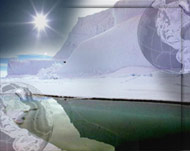Satellite to examine polar ice crashes
A European satellite that was to have helped understand global warming by scanning the thickness of polar ice sheets has crashed into the Arctic Ocean after its Russian launcher failed.

The €140 million ($170 million) Cryosat satellite blasted off from Russia‘s northwestern Plesetsk cosmodrome on Saturday atop a Russian-built Rockot launch vehicle but failed to achieve orbit.
“The satellite did not go into orbit because of a dysfunction in the final stage … of the Rockot launcher,” Vyacheslav Davidenko, spokesman for the Russian Space Agency was quoted as saying by Interfax.
“We suppose that the satellite with its booster fell at the site intended for that purpose, into the Lincoln Sea, near the North Pole,” Lieutenant-General Oleg Gromov, deputy commander of the Russian Space Forces, was quoted as saying by Itar-Tass news agency.
The ESA official in charge of the Cryosat project, Pascal Gilles, said they had received confirmation from the Russians that the satellite had been lost after the second stage of the rocket failed to separate.
“The second stage continued to burn after the onboard computer told it shut down. There was no separation between the second and third stages of the rocket, and the third failed to ignite. The whole thing … fell into the Artic Ocean.”
Loss
Gilles said the satellite’s crash resulted in the loss of five to six years of work for the engineers and scientists involved.
 |
|
The Cryosat was to have studied |
The Rockot is a converted Soviet-era SS-19 ballistic missile with an additional Breeze-KM upper stage.
Russia intends to suspend all Rockot launches until the Cryosat incident has been investigated, Davidenko said, adding that the Rockot’s developers, the Khrunichev space centre, had already offered an apology to the ESA for the launch’s failure.
ESA was expected to make an announcement on Monday on what steps it would take regarding the Cryosat, which was just the first of a series of six ESA Earth Explorer satellites designed to explore key environmental problems.
The 711kg Cryosat was to have scanned the thickness of polar ice sheets and floating sea ice to an unprecedented accuracy, providing a much-needed tool to climate scientists.
Satellite date
Satellite data suggest that this ice cover has been shrinking at around 3% per year since the 1970s, although information about its thickness – a critical factor in how serious the problem could be – remains sketchy.
Last month, US researchers said the Arctic ice cap is now at its smallest for more than a century.
|
“The whole thing … fell into the Artic Ocean“ Pascal Gilles, |
In August, a study published in the British journal Nature determined that the collapse of a huge ice shelf in Antarctica in 2002 had no precedent since the end of the last Ice Age 11,000 years ago.
The Larsen B iceshelf, measuring some 3250sq km in area, broke away from the eastern Antarctic peninsula – a “hot spot” where temperatures have risen by around 2C over the past half-century.
Greenhouse-gas negationists insist that such warming is part of a natural cycle in the planet’s orbit and inclination that has caused many climate shifts in the past.
Many scientists, though, dismiss such opinions, saying instead that the warming was man-made, coming from carbon-gas pollution from fossil fuels which store heat from the Sun instead of letting it radiate into space.